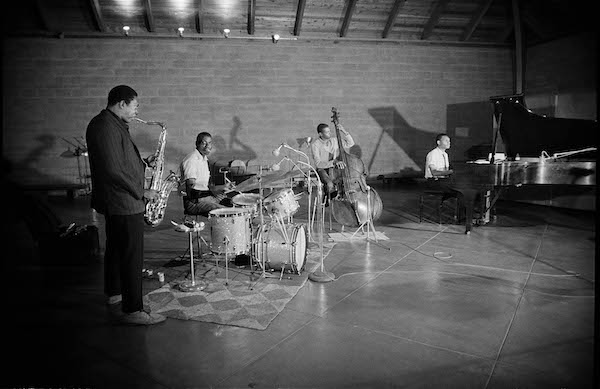Apr 2, 2024 12:59 PM
Saxophonist, Sonic Explorer Casey Benjamin Dies at 45
Casey Benjamin, the alto saxophonist, vocalist, keyboardist and producer who stamped his distinctive sounds on the…

On June 29, the Impulse! label will issue previously unreleased studio recordings by John Coltrane (left), Elvin Jones, Jimmy Garrison and McCoy Tyner under the title Both Directions At Once: The Lost Album.
(Photo: © Jim Marshall Photography LLC)As to why the album wasn’t released before his father’s death, Ravi said that the session may have been intentionally exploratory. “The session was recorded the very same week as the Johnny Hartman session, and the band [was about to conclude] a two-week run at Birdland. For me it did feel like, ‘OK, well, we’re doing a few sessions this week. One of them will maybe get the band warmed up, so why don’t we lay down some of the things we have been performing at Birdland all week?’ It does feel very much like a live set recorded in a studio.”
Part of that may be the amount of space these tracks give Garrison and Jones. For instance, the album-opening “Untitled Original 11383–Take 1” features a rare, driving arco solo by Garrison, while “Nature Boy” relies heavily on the way Jones’ shuffling polyrhythms contrast against Garrison’s repeated use of a syncopated anchor based on two dotted quarter notes followed by a quarter note. The two takes of “One Up One Down” both notably feature a shout chorus with Jones.
“You do get to hear the role of the rhythm section a little bit differently,” Ravi said. “There’s lots of drum solos. There’s lots of bass solos. Again, it does take on the character of a live performance.”
On a more conventional session, such as the one with Hartman, there would be less space for the rhythm section to stretch out or show off. “On those record dates, the arrangements were very, very tight, and if there were any solos at all, it was going to be a saxophone solo and a piano solo,” he added. “But on this record, you get a chance to hear the rhythm section really, really interact. Lots of great moments between Elvin and Jimmy Garrison, for sure.”
Above all, Both Directions At Once works as a snapshot of a great band on the cusp of revolution. “There are elements of the performance that do hark back to John Coltrane’s early days as a blues player and a bebop player,” Ravi said, pointing to “Vilia” and the 11-minute “Slow Blues.” But there is also material like “One Up One Down,” which, he says, “is leaning toward the music that John and the quartet eventually get to, in 1964 and ’65, playing more of these open structures. So it’s kind of a rare glimpse, to see John with one foot in the past, and one foot in the future.” DB

Benjamin possessed a fluid, round sound on the alto saxophone, and he was often most recognizable by the layers of electronic effects that he put onto the instrument.
Apr 2, 2024 12:59 PM
Casey Benjamin, the alto saxophonist, vocalist, keyboardist and producer who stamped his distinctive sounds on the…

“He’s constructing intelligent musical sentences that connect seamlessly, which is the most important part of linear playing,” Charles McPherson said of alto saxophonist Sonny Red.
Feb 27, 2024 1:40 PM
“I might not have felt this way 30 to 40 years ago, but I’ve reached a point where I can hear value in what people…

Albert “Tootie” Heath (1935–2024) followed in the tradition of drummer Kenny Clarke, his idol.
Apr 5, 2024 10:28 AM
Albert “Tootie” Heath, a drummer of impeccable taste and time who was the youngest of three jazz-legend brothers…

“Both of us are quite grounded in the craft, the tradition and the harmonic sense,” Rosenwinkel said of his experience playing with Allen. “Yet I felt we shared something mystical as well.”
Mar 12, 2024 11:42 AM
“There are a few musicians you hear where, as somebody once said, the molecules in the room change. Geri was one of…

Henry Threadgill performs with Zooid at Big Ears in Knoxville, Tennessee.
Apr 9, 2024 11:30 AM
Big Ears, the annual four-day music celebration that first took place in 2009 in Knoxville, Tennessee, could well be…